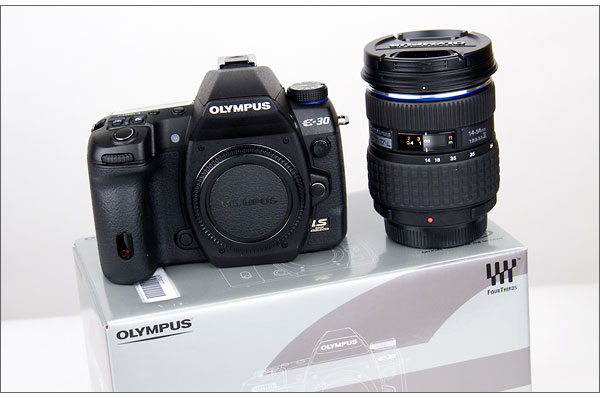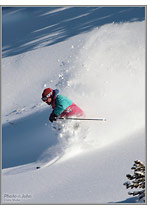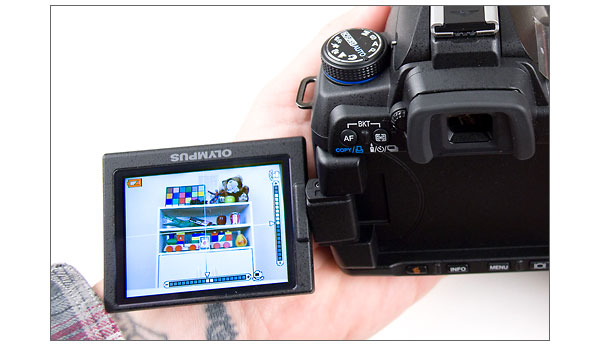We were lucky enough to be one of the first to get the new 12-megapixel E-30 digital SLR from Olympus. Rather than wait for a complete review, I’ve been shooting with the E-30 for the past few days so I can put together some initial impressions.

 For a complete overview of the camera, you can read my Olympus E-30 Announcement article. There’s also a short video at the bottom of this page. In the meantime here’s a quick overview: The Olympus E-30 is a 12.3-megapixel digital SLR positioned between the Olympus E-520 and the top-of-the-line Olympus E-3, both of which are 10-megapixel cameras. The E-30 actually shares a lot of features and technology with the E-3. The most important of the shared features, in my opinion, are the tilt/swivel LCD and the 11-point auto focus system. Both of these really set the E-30 apart from the smaller and simpler E-520. It also has a cool new Level Gauge, which you can see in the LCD photo below. The E-3 has a much more substantial build than the E-30, although they’re about the same size and actually use the same battery grip. The E-30 also lacks the E-3′s weather-sealing and rugged internal metal chassis. But as far as performance goes, it’s honestly hard to tell the difference. I shot some ski photos with the E-30 in the continuous auto focus mode and they rocked!
For a complete overview of the camera, you can read my Olympus E-30 Announcement article. There’s also a short video at the bottom of this page. In the meantime here’s a quick overview: The Olympus E-30 is a 12.3-megapixel digital SLR positioned between the Olympus E-520 and the top-of-the-line Olympus E-3, both of which are 10-megapixel cameras. The E-30 actually shares a lot of features and technology with the E-3. The most important of the shared features, in my opinion, are the tilt/swivel LCD and the 11-point auto focus system. Both of these really set the E-30 apart from the smaller and simpler E-520. It also has a cool new Level Gauge, which you can see in the LCD photo below. The E-3 has a much more substantial build than the E-30, although they’re about the same size and actually use the same battery grip. The E-30 also lacks the E-3′s weather-sealing and rugged internal metal chassis. But as far as performance goes, it’s honestly hard to tell the difference. I shot some ski photos with the E-30 in the continuous auto focus mode and they rocked!

Olympus conceived the E-30 with a different kind of photographer in mind – someone they’re calling the “Creator.” The Creator is a designer, artist, student, or maybe a small business owner. They want a high-performance camera, but maybe they don’t want to do a ton of post-processing. To that end, Olympus has included three key new features intended to make it easier to get the shot in the camera – Art Filters, Live View Multi Exposure, and Multi Aspect shooting capability. Since this is just a preview, I haven’t tested all of these and I’m not going to go into too much detail. Once again, for more information, you can read my Olympus E-30 Announcement article.
I’ve played with the Multi Exposure feature and it is cool, although I don’t have anything worth showing yet. The Art Filters differ from the typical in-camera filters in that they’re applied while you’re shooting. It’s significant that they’re selected via the ART/SCN option on the mode dial and not buried in an image editing playback menu. And they’re really more akin to scene modes than the kind of in-camera effects that have been included on cameras for a while now. By combining metering, processing, and the “Art Engine,” Olympus claims that the quality of the Art Filter images will be better than in-camera effects applied after capture. I have to admit I was skeptical and felt like they were probably meant for someone else. But when I started to play with the Art Filters, I got kind of excited at the some of the results. And the perfectionist in me was pleased that you can shoot RAW + JPG and have an untouched RAW image available if you need it. There are six Art Filters – Pop Art, Soft Focus, Pale & Light Color, Light Tone, Grainy Film, and Pin Hole. So far, I am finding the Pin Hole and Soft Focus filters to be the most pleasing. See examples of all the Art Filters below:
 |
||
| The original, unedited image, from the RAW file. Click to view. | ||
 |
 |
 |
| Art Filters (left to right): Pop Art, Soft Focus, and Pale & Light Color. Click thumbnails to view photos. | ||
 |
 |
 |
| Art Filters (left to right): Light Tone, Grainy Film, and Pin Hole. Click thumbnails to view photos. | ||
As you can see, there’s nothing really crazy in the Art Filters. They’re basically tried-and-true effects, done really well. Sure you could do them yourself in Photoshop. But I’m finding that being able to just make a mode change and get sophisticated effects in-camera is really nice – especially when I can get a clean RAW file at the same time. Below are three more photos I shot with the Art Filters. I was especially surprised and pleased at what the Soft Focus filter did with what would have been a pretty mundane night shot of my front yard after a snowstorm.
 |
 |
 |
| Click thumbnails to view photos. | ||
| Olympus E-30 Studio Test Images | ||
| ISO 100 Sample >> ISO 200 Sample >> ISO 400 Sample >> ISO 800 Sample >> ISO 1600 Sample >> ISO 3200 Sample >> |
||
We’re working on a complete, detailed review of the Olympus E-30. But hopefully this answers some of your initial questions and gives you an idea of how it works and where it fits in the Olympus digital SLR lineup. If you’ve got an E-510, E-420, or E-520 and you’re looking for more, the E-30 is definitely an excellent upgrade. It will outperform those cameras in every way. Compared to the E-3 it’s a tougher call. Then the question is whether you need the rugged build or not. If you don’t – and most people don’t – then the E-30 is probably the better choice.
Olympus E-30 Unboxing Video:
Other Resources:
Olympus E-30 User Review Page >>
Write a Olympus E-30 Review >>
Olympus E-30 Camera Specs >>
Olympus E-30 Sample Gallery >>
All Olympus Digital SLR Reviews >>
All Digital SLR Reviews >>
Olympus Cameras Forum >>
Digital SLRs Forum >>
Olympus Digital Cameras Web Site >>
All Digital Camera Pro Reviews >>
Digital Camera Buyer’s Guide >>
All Digital Camera Sample Images >>


Great looking camera John, I am curious how the IQ stands up against the E3.
Greg-
You can compare the sample photos of both cameras and make your own decision. All studio sample photos are listed on our Digital Camera Sample Photos page. I haven’t really looked at the image quality yet. But my guess would be that the E-30 is slightly better than the E-3, just because the sensor is newer and it doesn’t have that much more resolution. Our final review will take a closer look at the image quality of the E-30. But for now I’lll just say I’ve got no complaints.
It looks it us a great camera, i will wait for the full review, but for now i am pleased, the studio samples look very good and the photos too.
Niiice video.
I especially liked seeing the size comparisons with the E-520 and E-3.
does anyone know if that was suppose to be the ea-1 and they just went with e-30 instead, cause it looks exa alike in this sneak peak video http://www.youtube.com/watch?v=7vbY47K50OY
Chris-
It does look like the same camera. Olympus did make an announcement in September. They said they had a new Four Thirds camera in development that would fall between the E-520 and the E-3. And the camera in the video certainly looks a lot like the E-30.
Nice, thanks!
Maybe the E-30 can be my grown up camera.
And I am totally digging the unboxing video jumpsuit.
John: Great preview of another great OLYMPUS product. I am a “Post-Processing” kinda guy, so the “Art Filters” didn’t hit a home run with me. I prefer the RAW shot, and the use of CS3 after shooting. Just a preference of my own. I do see value in the “Art Filters,” for folks that want to capture a finished product, “On-the-fly.” I was really impressed with the LEVELING tool. Leveling is one element in shooting where I can use all the help I can get!
I am really enjoying my E3, and I now have another comparable quality Olympus to recommend to my friends. The VIDEO rocks, as well as your excellent knowledge of the Olympus line. Thanks so much for all you do for us here!
- Tim
oh…are you selling Photo Review Jumpsuits?